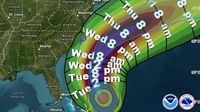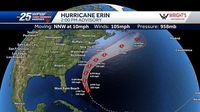Hurricane Erin, the first hurricane of the 2025 Atlantic season, is leaving a dramatic mark on the U.S. East Coast, even without making landfall. As of August 19, 2025, Erin is a sprawling, high-end Category 2 hurricane, nearly reaching Category 3 status, and is responsible for a cascade of dangerous conditions from the Carolinas to New England. The storm’s presence is being felt through life-threatening rip currents, towering waves, and widespread beach closures, with officials up and down the coast racing to keep residents and visitors safe.
According to the National Hurricane Center and reporting from CNN, Erin’s sustained winds are just shy of Category 3, and its tropical-storm-force winds now extend more than 200 miles from its center, expected to reach 280 miles by Thursday. The storm is moving north, nearly paralleling the coast, and while it’s not forecast to make landfall, its sheer size is generating hazardous surf and coastal flooding. Bermuda, lying to the east, is also bracing for similarly rough seas and potentially tropical-storm-force winds later this week.
The impact is already evident. On Monday, August 18, around 90 rip current rescues were conducted in North Carolina alone, with 75 in New Hanover County and 15 in Surf City, according to local officials cited by CNN. Wrightsville Beach issued a no-swim advisory through Friday, August 22, underscoring the seriousness of the threat. In New Jersey, forecasters are warning of very rough surf, wind gusts up to 30 mph, minor coastal flooding, and dangerous rip currents in the coming days. As a result, Island Beach State Park has closed swimming and other activities until further notice, and other shore towns like Belmar and Bay Head have raised red flags, signaling no swimming allowed.
New Jersey Governor Phil Murphy didn’t mince words at a Tuesday morning news conference, stating, “This is no time to be complacent. I would say to you flat out don’t go in the water.” He added, “Going into the ocean for the next number of days is something you gotta avoid.” New York City beaches are following suit, closing for swimming on Wednesday and Thursday due to hazardous conditions, though the sand remains open. Long Island’s beaches, particularly those in the Town of Hempstead, will also be closed to swimming and bathing on those days, with the possibility of closures extending into Friday if dangerous conditions persist. “All of our town of Hempstead beaches will be closed to swimming and bathing both Wednesday and Thursday of this week, with the potential for beaches to be closed Friday as well. If dangerous conditions persist, we’ll make that call on Thursday,” said Hempstead Town Supervisor John Ferretti.
North Carolina’s Outer Banks are under especially urgent threat. A tropical storm warning stretches from the middle of the state’s coast up to Duck, just north of Kitty Hawk. A tropical storm watch is in effect for the northern Outer Banks up to Cape Charles Light, Virginia. Dare and Hyde counties have declared local states of emergency and issued mandatory evacuations for Hatteras and Ocracoke islands. Officials are urging everyone to leave before seawater overtakes Highway 12, the slender and scenic road that serves as the main artery connecting these barrier islands. Dare County Emergency Management Director Drew Pearson delivered a blunt message: “I encourage all residents and visitors to heed the evacuation order and take action to protect themselves, to protect their property, and to get up and leave — now.”
The storm surge is a major concern. The National Weather Service in Morehead City, North Carolina, warned on Tuesday that waves of 20 feet or more are forecast this week in the Outer Banks, likely causing severe beach and coastal damage. Protective sand dunes could be inundated and destroyed, which could lead to severe flooding inland. The tides around the Outer Banks will be at their highest levels of the month on Wednesday and Thursday, further compounding the risk. The National Hurricane Center has issued a storm surge warning for much of the region, predicting life-threatening inundation of 2 to 4 feet above ground level.
Erin’s impact isn’t limited to the United States. The storm’s outer bands recently lashed the Turks and Caicos Islands and the southeast Bahamas, causing flooding, power outages, and airport closures. Puerto Rico also suffered flooding and widespread power outages as the hurricane swept past. As reported by NBC News, Erin reached hurricane-force winds on Friday, August 15, and rapidly intensified to a Category 5 storm with sustained winds over 157 mph by Saturday, August 16. This burst of strength made Erin one of the fastest North Atlantic storms to reach Category 5 status, based on government hurricane data. Since then, the storm has weakened, but its threat remains potent due to its size and the extensive area affected by its winds.
Erin’s tropical-storm-force winds are now projected to extend up to 230 miles from its center, with hurricane-force winds reaching out 80 miles. The National Hurricane Center cautions that the storm’s massive wind field is “considerably larger than average compared to the wind field” that its predictions are based upon. This means that even communities far from the storm’s center are at risk of tropical-storm-force winds, especially along the coast from North Carolina to southern New England.
Why does the size of the storm matter so much? According to Matthew Janssen, a research assistant professor and engineer at the Stevens Institute of Technology in New Jersey, “The size of the storm really is correlated with higher storm surge levels over larger swaths of area, and that tends to lead to much more dramatic impacts.” The Outer Banks, with their narrow stretches of land, are particularly susceptible to being washed out, even by moderately strong storms. Janssen notes, “In some parts of that, the barrier islands may be a thousand feet wide in some areas. So very, very vulnerable to even moderately strong storms.”
Looking forward, the Atlantic hurricane season is entering its most active stretch, typically kicking off in mid-August. The National Hurricane Center is monitoring two additional areas for possible tropical development in the same region where Erin recently traveled. If these systems develop, they will be named Fernand and Gabrielle. The first is a disorganized cluster of showers and thunderstorms with a medium chance of becoming a tropical depression or storm within the week, while another area near Africa’s Cabo Verde islands has a low chance of development before running into more hostile atmospheric conditions.
Experts warn that climate change is fueling more intense hurricanes, even if the overall number of storms may not increase. “The leading consensus among most experts is that the effects of climate change on hurricane formation will be fewer hurricanes, but we will [see] more intense storms,” Janssen said. “Specifically, more frequent major [Category 3 or greater] storms. Erin, in some ways, plays right into that narrative.” Warmer air and ocean temperatures provide more fuel for extreme weather, raising the risk of flooding—the main cause of death during hurricanes.
As Hurricane Erin continues its journey up the Atlantic, the East Coast remains on high alert. With mandatory evacuations, beach closures, and relentless waves battering the shoreline, officials are urging everyone to heed warnings and stay out of the water. The message is clear: this is not the time for risk-taking. As the 2025 hurricane season ramps up, the lessons from Erin’s massive reach and rapid intensification will likely echo for months to come.






